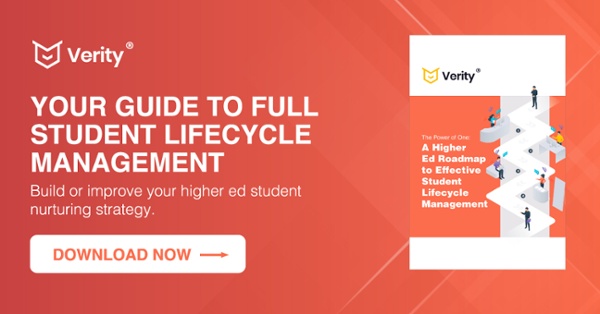What is the Best CRM Software for College and University Admissions?
There are a lot of Higher Ed software companies that make promises of having the best solution on the market, whether it’s an admissions CRM (contact relationship management), SIS (student information system), CMS (content management system), or another useful tool.
Here’s the problem, though: there is no “one size fits all” solution.
Every school has unique needs, depending on its size, location, budget, and a myriad of other things. The best CRM for an Ivy League university may not be the best CRM for a career college, and vice-versa.
That said, there are a handful of must-haves when it comes to college CRM software, no matter how big or small your institution is.
The best CRMs for college admissions are:
- Prioritizing the student experience
- Focusing on the whole student lifecycle
- Accurate with their data
- Scalable
- Intuitive and user-friendly
Keep reading for a full breakdown of what you should look for in each of these features.
1. Prioritizing the Student Experience
Above all else, the best CRMs for schools are primarily focused on the student experience.
Yes, you’d love to have features like automation, accurate data, a user-friendly interface, and easy reporting—all of those things are important.
However, if your priority isn’t to deliver incredible student experiences with every interaction, then you risk putting yourself in a situation where students are underwhelmed with their experience and don’t find value in your communication.
As the saying goes: “Meet your students where they are.” That means building a cohesive multichannel communication strategy, allowing each student to engage how they prefer.
Make sure you avoid pitfalls like:
- Overcommunicating to students
- Not adding value with every touch
- Only communicating when you need something from them (like meeting a deadline)
- Not offering flexibility for which channels they use
For a few more tips on delivering better student experiences, check out these resources.
2. Focusing on the Whole Student Lifecycle
Your CRM should enable you to manage the entire student lifecycle, from prospect to enrolled student to alumni… and everything in between.
What does that look like?
For one thing, being able to segment your contacts by where they are in their journey is a necessity for building more targeted campaigns based on audience behavior.
For example, you should be able to easily pull a list of prospects who’ve submitted an RMI form or enrolled students who live in a certain geographic area.
If you need to do a lot of manual work or go collect data from different departments in order to build that list, then you probably don’t have the right CRM in place.
To build a better strategy for the entire student journey, download our guide:
The Power of One: A Higher Ed Roadmap to Effective Student Lifecycle Management
3. Accurate Data and Reporting
You need to have access to data that you trust. Period.
CRMs are powerful tools and when used properly, they can provide insights that help Higher Ed institutions make informed strategic decisions.
Say, for example, that you’re approaching the application deadline and you’re not hitting your enrollment goals. You should be able to see exactly how many students are at each stage of the funnel and then go target them with additional touches of encouragement and calls to action.
Think of your “high-value” prospects who have shown serious intent but haven’t actually crossed the finish line. People who have met with an advisor but haven’t started their app or people who have started their app but haven’t finished it are two segments of your audience that you definitely want insights into.
Can you do that if you don’t have data you trust?
4. Scalable
The term “scalable” is one that gets thrown a lot in the software world, but what does it really mean?
In Higher Ed terms, scalable means that your CRM should be able to grow as your school grows, at any pace you need it to.
Maybe you’re looking to adopt a new CRM (or really any Higher Ed software!) but you aren’t ready to onboard your entire university. You could start small with one school or even one program and have the ability to get more sophisticated over time, gradually bringing in more programs onto the platform.
Or, if you want to launch the new software across all of your schools and programs, that’s great too. There are certainly many benefits to having all of your programs unified through a single CRM.
The point is that your CRM should be able to do both. As we said, it should grow with you at your chosen pace.
5. Intuitive and User-Friendly
Being intuitive and user-friendly are super important characteristics, but they can be hard to quantify. After all, the user experience is subjective.
For example, you might expect that your 25-year-old marketing manager is able to adapt more quickly to a new tech stack than someone who’s older and has been working at the school for 20 years, but that may not necessarily be the case. There’s always a user adoption curve, but you need to know that your team will be able to learn the software and be confident using it. That’s why it’s critical to communicate with your team about the software and ensure they are up for the challenge!
And—this should go without saying—your university admissions software should make jobs easier, not harder.
This means that CRMs should eliminate as much manual, repetitive, and error-prone work as possible to free up your team’s time to focus on more things that matter.
For more ideas about what you should be looking for in your CRM and other software, check out our blog: 6 Common Features of the Best Higher Ed Enrollment Management Software.


